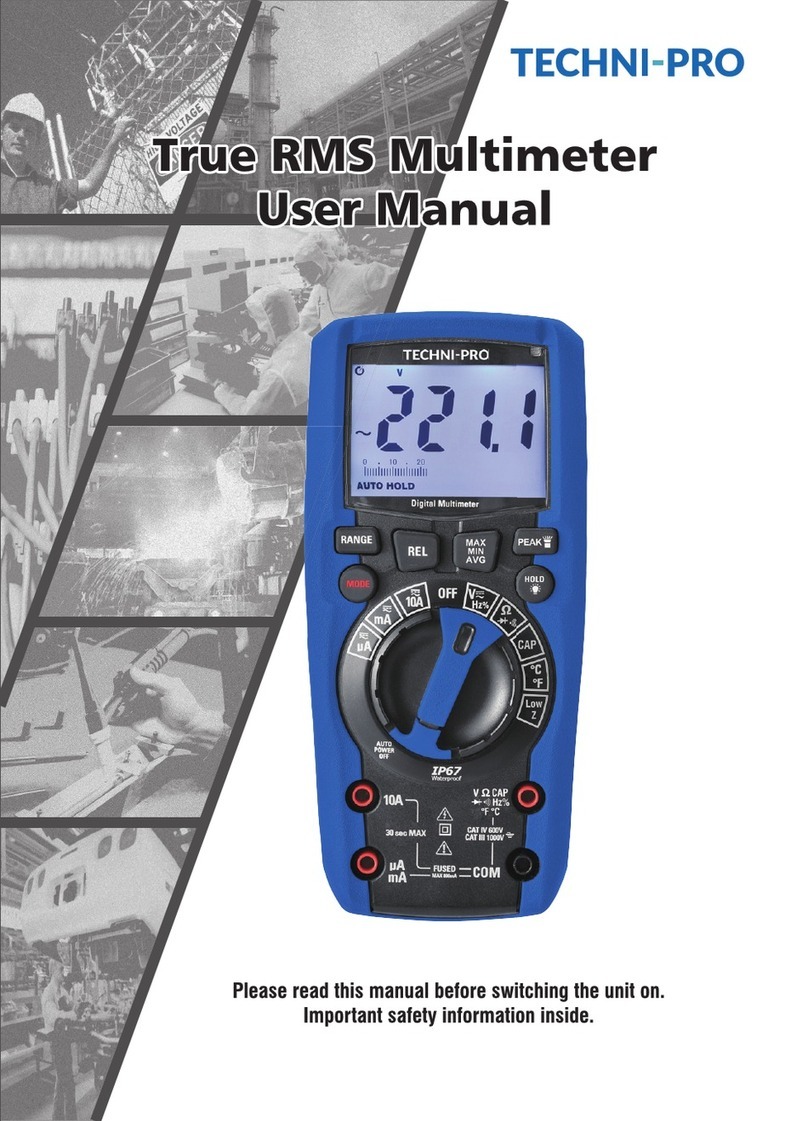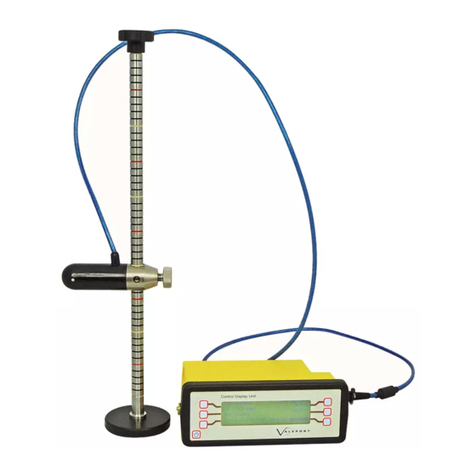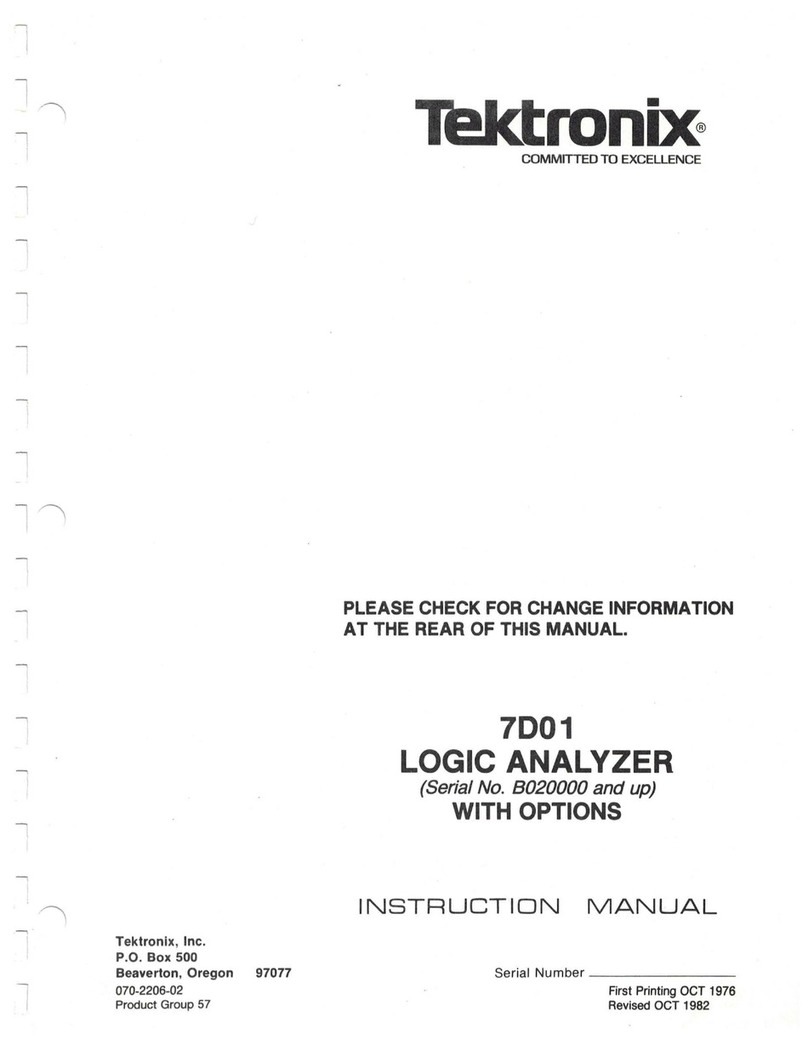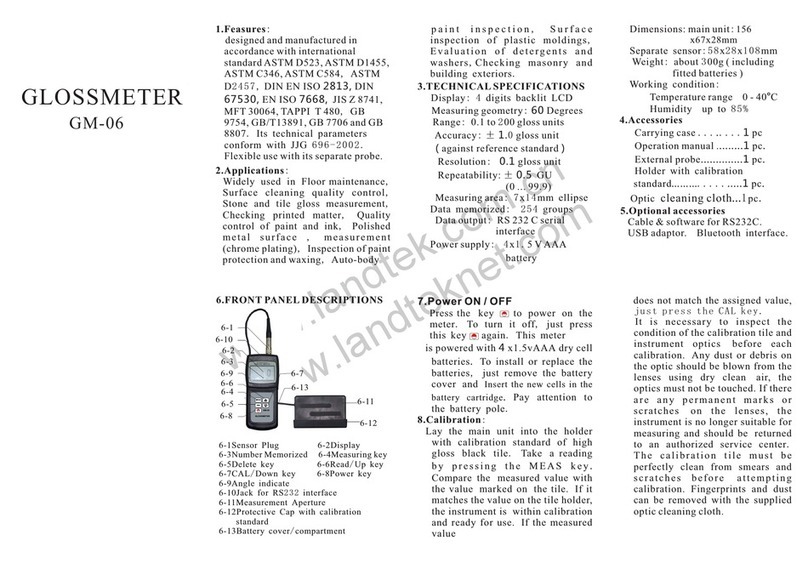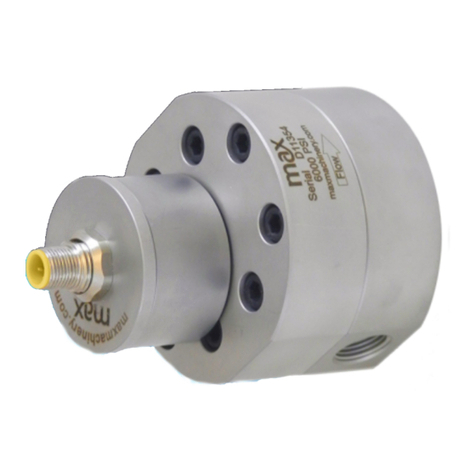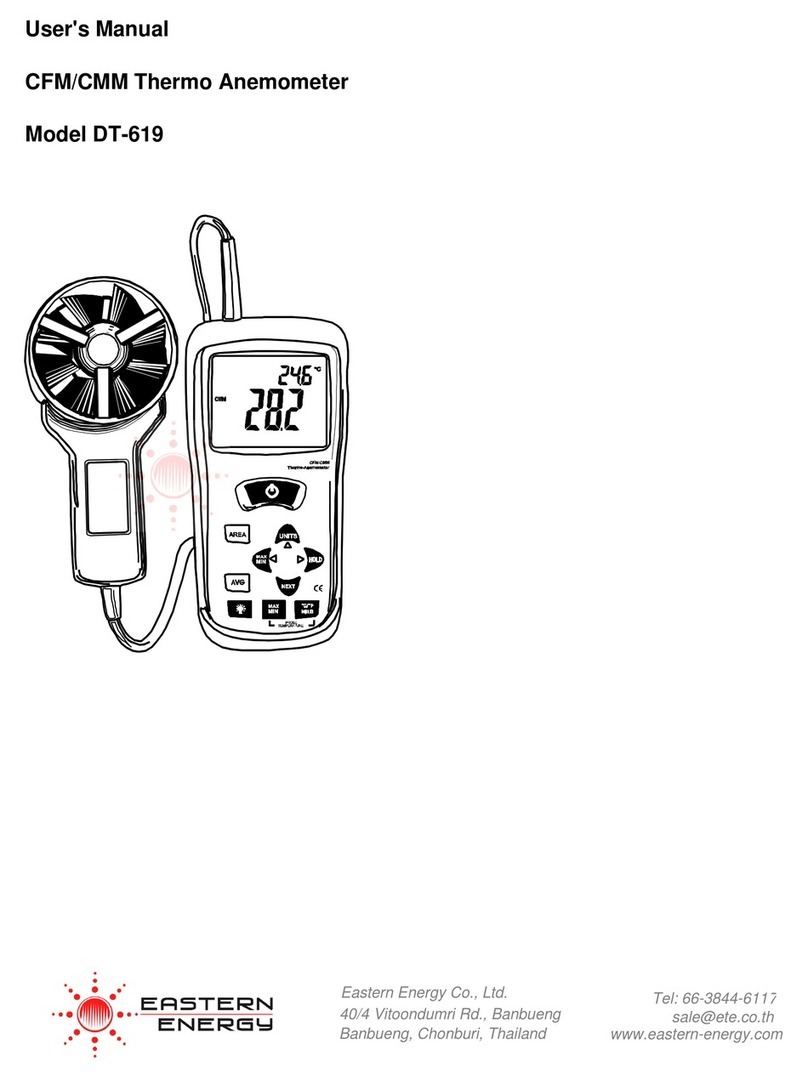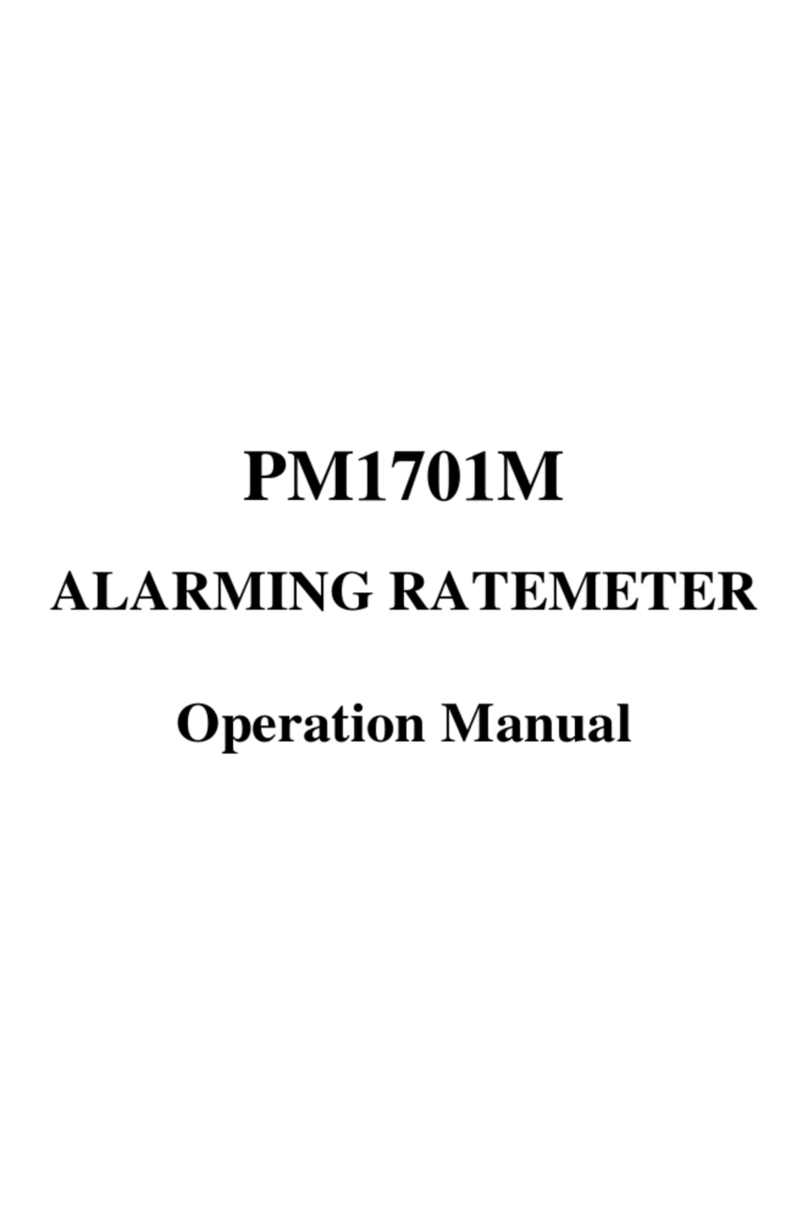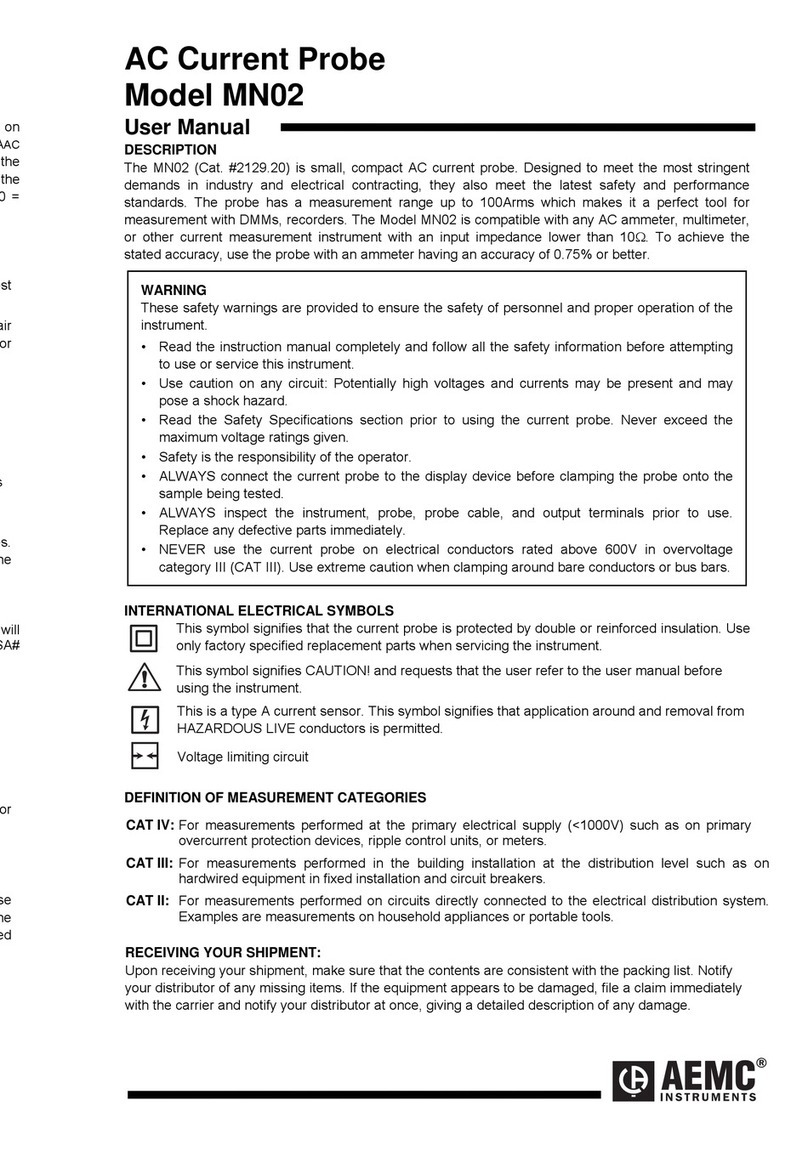TECHNI-PRO TNP477 User manual

Please read this manual before switching the unit on.
Operating Instructions for
AC/DC TRMS CLAMP METER
Important safety information inside.


3
AC/DC TRMS CLAMP METER
Page
4
4
4
4
5
5
6
6
8
9
9
9
9
9
9
9
9
10
10
11
12
13
14
15
16
17
18
19
19
19
20
20
22
Content
1.Introduction.................................................................................
2.Safety..........................................................................................
2-1.International Safety Symbols...................................................
2-2.PER IEC1010 OVERVOLTAGE INSTALLATION CATEGORY...............
2-3.Safety Notes...........................................................................
2-4.Input Limits............................................................................
3.Description..................................................................................
3-1.Meter Description....................................................................
3-2.Display Icons Description.........................................................
4.Function.......................................................................................
4-1.Data Hold................................................................................
4-2.LCD Backlight.........................................................................
4-3.MAX/MIN................................................................................
4-4.Peak Hold...............................................................................
4-5.INRUSH...................................................................................
4-6.Automatic Power OFF with Disable...........................................
4-7.Low Battery Indication.............................................................
5.Operation.....................................................................................
5-1.AC/DC Current Measurement....................................................
5-2.AC/DC Voltage Measurement....................................................
5-3.Resistance Measurement.........................................................
5-4.Continuity Measurement..........................................................
5-5.Diode Test...............................................................................
5-6.Capacitance Measurement.......................................................
5-7.Frequency/Duty Cycle Measurement.........................................
5-8.Temperature Measurement......................................................
5-9.Non-Contact AC Voltage Measurement....................................
6.Maintenance................................................................................
6-1.Cleaning and Storage..............................................................
6-2.Battery Replacement...............................................................
7.Specifications..............................................................................
7-1.Technical Specifications..........................................................
7-2.General Specifications.............................................................

4
AC/DC TRMS CLAMP METER
1.Introduction
• The True RMS Clamp Meter measures DC Current up to 1000A and AC Current up to 3000A.
• Other functions include AC/DC Voltage, Resistance, Continuity, Diode Test, Capacitance, Frequency, Duty Cycle
and Temperature.
• A built-in flashlight and non-contact AC voltage detector provide added convenience.
• Bluetooth communication allows readings to be displayed and stored on mobile devices.
• This meter is fully tested and calibrated and, with proper use, will provide many years of reliable service.
2.Safety
2-1.International Safety Symbols
This symbol, adjacent to another symbol or terminal, indicates the user must refer to the manual for further
information.
This symbol, adjacent to a terminal, indicates that, under normal use, hazardous voltages may be present.
Double insulation.
This WARNING symbol indicates a potentially hazardous situation, which if not avoided, could result
in death or serious injury.
This CAUTION symbol indicates a potentially hazardous situation, which if not avoided, may result
damage to the product.
2-2.PER IEC1010 OVERVOLTAGE INSTALLATION CATEGORY
OVERVOLTAGE CATEGORY I: Equipment of OVERVOLTAGE CATEGORY I is equipment for connection to circuits in
which measures are taken to limit the transient overvoltages to an appropriate low level.
Note: Examples include protected electronic circuits.
OVERVOLTAGE CATEGORY II: Equipment of OVERVOLTAGE CATEGORY II is energy-consuming equipment to be
supplied from the fixed installation.
Note: Examples include household, office, and laboratory appliances.
OVERVOLTAGE CATEGORY III: Equipment of OVERVOLTAGE CATEGORY III is equipment in fixed installations.
Note: Examples include switches in the fixed installation and some equipment for industrial use with permanent
connection to the fixed installation.
OVERVOLTAGE CATEGORY IV: Equipment of OVERVOLTAGE CATEGORY IV is for use at the origin of the installation.
Note: Examples include electricity meters and primary over-current protection equipment.
WARNING
CAUTION

5
AC/DC TRMS CLAMP METER
2-3.Safety Notes
• Do not exceed the maximum allowable input range of any function.
• Do not apply voltage to meter when resistance function is selected.
• Set the function switch OFF when the meter is not in use.
• Remove the battery if meter is to be stored for longer than 60 days.
WARNINGS
• Set function switch to the appropriate position before measuring.
• When measuring volts do not switch to current/resistance modes.
• Do not measure current on a circuit whose voltage exceeds 600V.
• When changing ranges, always disconnect the test leads from the circuit under test.
CAUTIONS
• Always remove the test leads before replacing the batter
• Improper use of this meter can cause damage, shock, injury or death. Read and understand this user
manual before operating the meter.
y or fuses.
• Always discharge capacitors and remove power from the device under test before performing Diode, Resistance
• Inspect the condition of the test leads and the meter itself for any damage before operating the meter. Repair
or replace any damage before use.
• Use great care when making measurements if the voltages are greater than 25VAC rms or 35VDC, these voltages
are considered a shock hazard.
or Continuity tests.
• Voltage checks on electrical outlets can be difficult and misleading because of the uncertainty of connection
to the recessed electrical contacts. Other means should be used to ensure that the terminals are not “live”.
• Do not leave batteries and packing material lying around unattended; they can be dangerous for children if they
use them as toy
• This device is not a toy and must not reach children’s hands. It contains hazardous objects, as well as small
• If the equipment is used in a manner not specified by the manufacturer, the protection provided by the equipment
may be impaired.
parts which children could swallow. In the event parts are swallowed, seek medical help immediately.
s.
• In case the device is going to be unused for an extended period of time, remove the batteries to prevent them
from draining.
• Expired or damaged batteries can damage skin. Wear suitable gloves when handling.
• See that the batteries are not short-circuited, do not throw batteries into fire.
2-4.Input Limits
Maximum Input
3000A AC
1000A DC/AC
1000V DC/AC
250V DC/AC
30V DC, 24V AC
Function
3000A AC
1000A DC/AC
V DC/AC
Resistance, Capacitance, Frequency, Diode Test
Type K Temperature

6
AC/DC TRMS CLAMP METER
3.Description
3-1.Meter Description
1-Current Clamp
2-Non-Contact AC Voltage Indicator Light
3-Clamp Trigger
4-Bluetooth/Flashlight Button
5-Rotary Function Switch
6-Data Hold/Backlight Button
7-MODE Select Button
8-PEAK/INRUSH Button
9-Relative/Hz Button
10-MAX/MIN Button
11-LCD Display
12-3000A AC Input Jack
13-COM Input Jack
14-Positive Input Jack
15-Flash Light LED
16-Battery Cover
17-Flexible Current Probe
1
34
6
5
7
8
10
9
11
12
2
13
14

7
AC/DC TRMS CLAMP METER
16
15
17
Flexible
Clamp
CAT III 1000V
CAT IV 600V
MAX 3000A AC TRMS

8
AC/DC TRMS CLAMP METER
3-2.Display Icons Description
1-Bluetooth
2-Auto Power Off
3-Units of Measure List
4-Direct Current
5-Negative Reading Display
6-Alternating Current
7-Low Battery
8-Measurement Display Digits
23
1
8
4
5
6
7
9
10 11 12 13 14 15 16
9-Analog Bargraph
10-Auto Range Mode
11-Data Hold
12-Peak Maximum/Maximum
13-Peak Minimum/Minimum
14-Relative Mode
15-DC Zero
16-Inrush Current

9
AC/DC TRMS CLAMP METER
4.Function
4-1.Data Hold
• Press the HOLD/Backlight Button again to return to normal oper
• To freeze the LCD reading, press the HOLD/Backlight Button. While data hold is active, the HOLD icon appears
on the LCD.
ation.
4-2.LCD Backlight
• The LCD is equipped with backlighting for easier viewing, especially in dimly lit areas.
• Press and hold the HOLD/Backlight Button for two seconds to turn the backlight on or off
• The backlight will automatically turn off after 30 seconds.
4-3.MAX/MIN
• PPress the MAX/MIN Button to activate the MAX/MIN recording mode. The display icon “MAX” will appear
and the meter will begin recording and displaying the maximum value measured.
• Press the MAX/MIN Button again and “MIN” will appear. The meter will display the minimum value measured
during the recording session.
• Press the MAX/MIN Button again and “MAX MIN” will appear. The meter will display the present reading,
but will continue to update and store the max and min readings.
4-4.P
• To exit MAX/MIN mode, press and hold the MAX/MIN Button for 2 seconds.
eak Hold
• When ACA or ACV is selected, pressing the PEAK/INRUSH Button enables the peak capture circuit.
• The meter will now capture and display the maximum and minimum peaks of the waveform.
4-5.INRUSH
• When ACA is selected, press the PEAK/INRUSH Button to activate the inrush capture circuit.
• A transient condition, generally lasting 110-120 milliseconds that occurs during motor start-up.
4-6.Automatic Power OFF with Disable
• In order to conserve battery life, the meter will automatically turn off after approximately 30 minutes.
• To turn the meter on again, turn the function switch to the OFF Position and then turn to the desired function
position.
4-7.Low Batter
• To disable APO:
1.From the OFF Position, hold the MODE Button and rotate the function switch to a measurement function,
“ ” will appear in the display.
2.Release the MODE Button
3.APO is now disabled (APO icon is off) and will be reset when the function switch is returned to the OFF position.
y Indication
• When the “ ” icon and “-----” appears in the display, the battery should be replaced.
• Refer to the battery replacement procedure in the maintenance section.

10
AC/DC TRMS CLAMP METER
3000A AC
5.Operation
Notes: Read and understand all Warning and Caution statements in this operation manual prior to using this meter.
Set the function select switch to the OFF position when the meter is not in use.
5-1.AC/DC Current Measurement
WARNING: Disconnect the test leads before measuring with clamp.
1.Rotate the function switch to the 1000A AC/DC Position.
2.Press the MODE Button to select AC or DC.
3.Press the trigger to open jaw, fully enclose only one conductor.
4.Read the Current value in the display.
5.If the value is more than 1000A AC, connect Flexible Current Probe in parallel, rotate the function switch to the
Position then read resolution.
Flexible
Clamp
CAT III 1000V
CAT IV 600V
MAX 3000A AC TRMS

11
AC/DC TRMS CLAMP METER
5-2.AC/DC Voltage Measurement
CAUTION: Do not measure voltages if a motor on the circuit is being switched ON or OFF. Large voltage surges
may occur that can damage the meter.
1.S et the function switch to the VAC/DC or mVAC/DC Position.
2.I nsert the black test lead into the COM Input Jack and the red test lead into the Positive Input Jack.
3.Press the MODE Button to select AC or DC Voltage.
4.Touch the black test probe tip to the negative side of the circuit; touch the red test probe tip to the positive side
of the circuit.
5.Read the voltage value in the display.

12
AC/DC TRMS CLAMP METER
5-3.Resistance Measurement
Note: Remove power from the device under test before measuring resistance.
1.S et the function switch to the Position.Ω
2.I nsert the black test lead into the COM Input Jack and the red test lead into the Positive Input Jack.
3. Touch the test probe tips across the circuit or component under test.
4. Read the Resistance on the LCD display.

13
AC/DC TRMS CLAMP METER
5-4.Continuity Measurement
1.S et the function switch to the Position.Ω
2.I nsert the black test lead into the COM Input Jack and the red test lead into the Positive Input Jack.
3. Press the MODE Button to select continuity “ ”.
4. Touch the test probe tips across the circuit or component under test.
5. If the resistance is <50 , a tone will sound.Ω

14
AC/DC TRMS CLAMP METER
5-5.Diode Test
1.S et the function switch to the Position.Ω
2.I nsert the black test lead into the COM Input Jack and the red test lead into the Positive Input Jack.
3. Press the MODE Button to select continuity “ ”.
4. Touch the test probe tips to the diode or semiconductor junction under test.
5. Reverse the test lead polarity by reversing the red and black leads.
6. The diode or junction can be evaluated as follows:
• If one reading displays a value (Typically 0.4V to 1.8V) and the other reading displays “OL”, the diode is good.
• If both readings display “OL” the device is open.
• If both readings are very small or “O”, the device is shorted.

15
AC/DC TRMS CLAMP METER
5-6.Capacitance Measurement
WARNING: To avoid electric shock, discharge the capacitor under test before measuring.
1.S et the function switch to the CAP Position.
2.I nsert the black test lead into the COM Input Jack and the red test lead into the Positive Input Jack.
3. Touch the test probe tips across the part under test.
4. Read the Capacitance value in the display.
Note: For very large values of capacitance measurement it can take several minutes before the final reading
stabilizes.

16
AC/DC TRMS CLAMP METER
5-7.Frequency/Duty Cycle Measurement
1.S et the function switch to the Hz% Position.
2.I nsert the black test lead into the COM Input Jack and the red test lead into the Positive Input Jack.
3.Touch the test probe tips across the part under test.
4.Read the Frequency value on the display.
5.Press the REL/Hz Button to select the Duty cycle (%) measurement.
6.Read the Duty cycle value on the display.

17
AC/DC TRMS CLAMP METER
5-8.Temperature Measurement
1. Set the function switch to the TEMP Position.
2. Use the MODE Button to select °C or °F.
3. Insert the Temperature Probe into the COM and Positive Input Jack, observing polarity.
4. Touch the Temperature Probe head to the device under test, continue to touch the part under test with the probe
until the reading stabilizes.
5. Read the Temperature on the display.
WARNING: To avoid electric shock, be sure the thermocouple probe has been removed before changing to another
measurement function.

18
AC/DC TRMS CLAMP METER
5-9.Non-Contact AC Voltage Measurement
WARNING: Risk of Electrocution. Before use, always test the Voltage Detector on a known live circuit to verify
proper operation.
• Rotate the Function switch to any measurement position.
• Place the detector probe tip on the conductor to be tested. If AC voltage is present, the NCV detector will turn
on with a steady red light.
Note: The conductors in electrical cord sets are often twisted. For best results, rub the probe tip along a length
of the cord to assure placing the tip in close proximity to the live conductor.
Note: The detector is designed with high sensitivity. Static electricity or other sources of energy may randomly
trip the sensor - this is normal operation.

19
AC/DC TRMS CLAMP METER
6.Maintenance
WARNING: To avoid electrical shock, disconnect the meter from any circuit, remove the test leads from the input
terminals, and turn OFF the meter before opening the case. Do not operate the meter with an open case.
6-1.Cleaning and Storage
• Periodically wipe the case with a damp cloth and mild detergent; do not use abrasives or solvents.
• If the meter is not to be used for 60 days or more, remove the battery and store it separately.
6-2.Battery Replacement
WARNING: To avoid electric shock, disconnect the test leads from any source of voltage before removing the
battery cover.
1. Remove the Phillips head screw secures the rear battery door.
2. Open the battery compartment.
3. Replace the 9V battery.
4. Secure the battery compartment door with the screw.
WARNING: To avoid electric shock. do not operate the meter until the battery cover is in place and fastened
securely.
NOTE: lf your meter does not work properly, check the batteries to make sure that they are stll good and that
they areproperly inserted.

20
AC/DC TRMS CLAMP METER
7.Specifications
7-1.Technical Specifications
Range & Resolution
1000.0A
3000.0A (Flexible Current Probe)
1000.0A
500.00mV
5.0000V
50.000V
500.00V
1000.0VDC
400.00mV
4.0000V
40.000V
400.00V
750.0V
400.00
4.0000k
40.000k
400.00k
4.0000M
40.000M
500.00nF
5.0000µF
50.000µF
500.00µF
5.0000mF
Accuracy
±(2.5% + 5 digits)
±(2.8% + 8 digits)
±(0.1% + 4 digits)
±(0.2% + 5 digits)
±(1.0% + 9 digits)
±(1.0% + 9 digits)
±(1.0% + 4 digits)
±(2.0% + 9 digits)
±(3.0% + 9 digits)
±(3.5% + 40 digits)
±(3.5% + 9 digits)
±(5.0% + 9 digits)
Function
DC Current
AC True RMS Current
(50 to 1000Hz)
All AC Current ranges are specified from 5% of range to 100% of range.
DC Voltage
AC True RMS Voltage
(50 to 1000Hz)
All AC Voltage ranges are specified from 5% of range to 100% of range.
Resistance
Capacitance
Ω
Ω
Ω
Ω
Ω
Ω
Table of contents
Other TECHNI-PRO Measuring Instrument manuals
Popular Measuring Instrument manuals by other brands

Center
Center C315 instruction manual
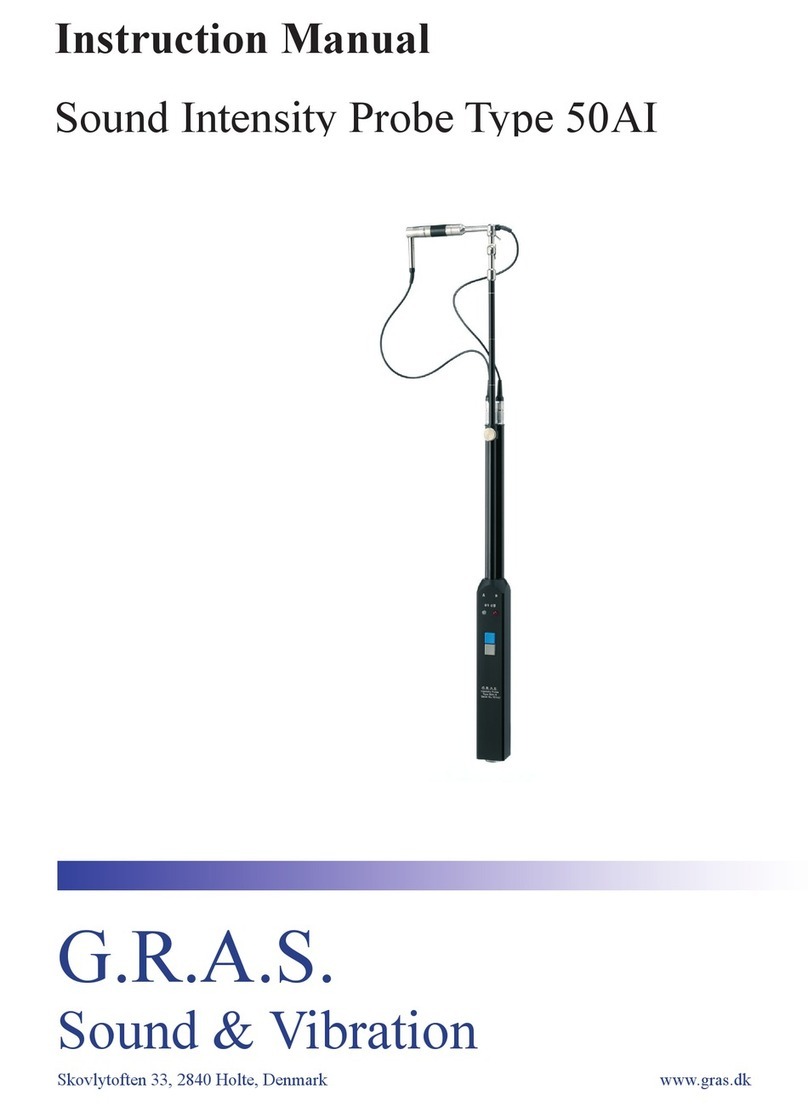
G.R.A.S.
G.R.A.S. 50AI instruction manual

Tuthill
Tuthill Fill-Rite 900 Series Owners installation, operation, and safety manual

Metso
Metso Nordtrack S Series instructions

SUTO
SUTO S415 Instruction and operation manual

Berthold
Berthold DUO XPERT LB 470RID operating manual
